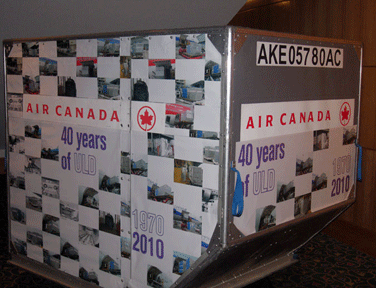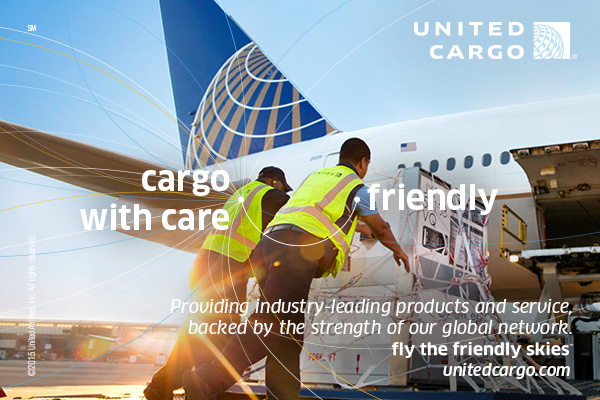
As IATA World Cargo
Symposium met in Shanghai, big financial rumblings were heard when China's
main stock indexes fell nearly 1 percent on Thursday, March 5, 2015, as
investors dumped blue-chip shares (such as banks and real estate firms),
driven by concerns about the slowing economy.
Chinese Premier Li Keqiang told the National
People's Congress (NPC) at the opening of the annual parliamentary meeting
that China would target growth this year of around 7 percent, down from
7.4 percent in 2014, signaling the lowest expansion for a quarter of a
century.
Last week China's stock market edged up
again, led by signs that fresh money is flowing into blue chips.
While day one of the WCS
was about the overall situation of the air cargo business (and its importance
for the Chinese market), day two is traditionally split into different
tracks, catering to the specific needs and specializations within the
industry.
One of the tracks catered to e-cargo and was delivered
in Mandarin, and was aimed at boosting the understanding on both sides
about what needs to be done to get e-cargo fully on track in the Chinese
mainland. Truth be told, China has homework to do, but on balance has
shown much further progress than other important markets, owing to both
the importance of air export trade for the Chinese economy and the ease
with which regulations can be changed on command in China.
Another track, titled “Pushing Technology
Boundaries” delivered updates about the current obstacles and cost
drivers relating to legacy software being used, inefficient interfaces
between the stakeholders in the air transport chain, and what the cargo
section might learn from already streamlined processes on the passenger
side.
As a reminder, the industry seemed to have much
less trouble implementing e-ticketing before 2007 than e-cargo, which,
according to IATA forecasts in 2010, was scheduled to be at 100 percent
by the end of 2014 but currently stands at slightly less than 25 percent
worldwide penetration.
We learned that Cargo self-service—much
like the CUSS (Common Use Self Service) kiosks on the passenger side—is
an option currently pursued, as this will give shippers and forwarders
more control of their shipment, the progress of transport, and other relevant
data.
Big Data
Analytic
While IATA’s update on “Big Data Analytic
– How Technology can be applied today for measurable benefit in
the real world” clearly showed some interesting options for synergies,
there is consensus that there’s still a long and bumpy road ahead
in terms of creating standards and making things happen throughout the
industry.
Smart sensing ULDs on the other side are currently
becoming a reality, and since these involve only airlines and handlers
while delivering obvious benefits, this technology is easier to implement.
Social Media
A look at “Social Media – How/Why
does the Air Cargo Industry become part of the Conversation” saw
some good questions asked, but little in the way of answers.
NDC for Air Cargo actually delivered a rather
heretic thought—at least seen from the view of FIATA:
NDC, or “New Distribution Capability” has gradually become
a reality on the passenger side during the last decade.
While traditionally air tickets were booked involving
travel agents (like cargo these days is typically shipped by means of
a forwarder), the last few years have seen passenger booking their tickets
directly with airlines, predominantly by means of the Internet.
What NDC represents to cargo is the elimination
of the middleman. This could cut down cost, increase efficiency, and strengthen
the shipper’s control over his – direct – shipment through
removal of issues related to the consolidation of shipments by forwarders.
Last but not least, a session, “Putting
the I-Pad on the forklift,” an analysis of operational paradoxes,
“Standardization versus Empowerment, Control versus Innovation,
Supervision versus unleashing.” Wrap up on this one, we think: a
nice head game with little practical relevance.
Pharma Connects
The Pharmaceutical track was one of the tracks
that actually delivered measurable benefit—for those who ship, handle,
produce, or transport pharma goods. Although even some pharma goods have
shifted to the maritime transport sector, air transport is still the predominant
and indispensable means of transporting vaccines and other perishable
pharmaceuticals over longer distances, simply because the risks increase
with increased duration of shipment time.
Chaired by LifeConEx DHL Global Head of Quality
Nina Heinz, the various aspects of risks and obstacles stakeholders in
the time-and-temperature critical supply chain were thoroughly analyzed.
Security
Track Value For Money
Another track that delivered measurable value-for-money
was the security track chaired by Jim Marriott, deputy director Aviation
Security and Facilitation of ICAO.
A provocative headline, “Terrorism is a
failed brand,” saw Enno Osinga, SVP Cargo SPL as interviewer and
Doug Brittin, director general TIACA as interviewee, discussing the not-so
obvious aspects of terrorism and its impact on global trade. Highlight
of that exchange was that security measures had received considerations
rather late after the crash of Pan Am flight 103 in Lockerbie, Scotland
in 1988 and specifically after 9/11.
Although these measures certainly added measurable
safety to aviation as such, the framework still shows considerable gaps
proven by the recent MH17 disaster over the Ukraine, as obviously neither
all airlines nor all regulators were aware of the unsafe Ukraine airspace.
An important message certainly was that the heightened
air security measures contribute to the modal shift from air transport
to surface-based transport.
The no less provocative question whether the air
transport industry should employ their own terrorists was—quite
clearly—answered with no, but nevertheless indicated that sometimes
finding the appropriate measures to combat terrorism also have moral implications.
 The outlook delivered by Wolfgang Lehmacher, (left)
head of Supply Chain and Transport Industries of the World Economic Forum,
was definitely the highlight of this above-average track
The outlook delivered by Wolfgang Lehmacher, (left)
head of Supply Chain and Transport Industries of the World Economic Forum,
was definitely the highlight of this above-average track
Elaborating about the “internet of things”
and its commercial applications as well as the intelligence of cargo,
Mr. Lehmacher explained in a most comprehensive manner the detrimental
effect of (trade) barriers and the fact that these barriers, although
negatively impacting trade, are driven by the needs of nation states to
protect these states’ varying interests.
Lehmacher concluded that since an e-Bay pilot
program suggested a significant upside in reducing those barriers, governments
as well as businesses should aim at reducing such trade barriers instead
of creating new ones and called for the creation of national mechanisms
as well as single national agencies tasked with the oversight of relevant
areas. In summary, his message was that a decrease in border challenges
would increase trade and thus GDP of nation states.
Still, in a balanced approach Mr. Lehmacher also
explained that the global risk landscape is having a considerable impact
on business operations citing as examples for global supply chain disruptors,
the Ebola outbreak in West Africa, the tensions in the Middle East, and
the Ukraine/Russian Federation border dispute, and that with such interconnected
risk factors driven by global trends, recent trends in supply chains have
changed risk distribution.
He recommended that governments and businesses
build trusted networks and improve the collaboration between the various
governmental agencies and other stakeholders as well as making risk a
key element in procurement, management, and governance.
His conclusions were deepened with a panel discussion
“Imagine Global Security Driven by Communication – why Security
of the Future should build Bridges rather than Walls.” A major point
here was the importance of customs information as an additional indispensable
layer of security, while identifying as one main obstacle the fact that
each nation state has its own security regime and its own approach to
sharing such valid information.
Stating the organic nature of terrorism, it was
summarized that terror can and must be fought but probably can never be
eliminated altogether, emphasizing the importance of the vial 3 C elements
of security: Cooperation, Coordination, and Consultation.
Supply Chain
Management Track
The Supply Chain Management Track focused on multi-modal
solutions and the trend to move away from the outdated trend analysis
to real-time asset tracking and information as well as modern-time options
generated by means of IT solutions to connect supply and demand.
Connecting China and Europe by means of rail links
was one important topic and the “optimal transport mix”—where
such a thing exists—another. The envisioned reopening of the Silk
Road for road transport of goods from the Far East, proposed by the International
Road Transport Union IRU, here must be called a rather crude byline, given
distance and obstacles involved.
Again, the focus was on improving information
and transparency in transportation throughout the supply chain. Robert
Mellin, Head of Distribution Logistics at Ericsson was at the center of
the discussion.
Highlighting
Regulations
The regulations track must be called another highlight
of this year’s WCS, since it summarized important regulatory updates
in one comprehensive track.
Chaired by Dough Brittin, the cost impact of regulatory
measures on airlines was identified, followed by a short recap of the
essential regulatory background on pharma EU Good Distribution Practices
(GDB), delivered again by Nina Heinz who delivered a clear message: The
patient comes first, which makes all the difference for life science customers
and makes SISPQ (Safety, Integrity, Strength, Purity and Quality) an indispensable
prerequisite for the distribution of such goods.
Going Postal Surprises
“Why are regulators removing security exemptions
for mail – consequences for airlines and other stakeholders”
at first glance looked to be a rather dry subject but actually showed
some significant insight.
 Delivered
by Antonis Kastrissianakis, (left) director Safety And Security at the
European Commission, and Bilal Ahmad Khan, program manager Customs and
Transport at the Universal Postal Union (UPU), the news is that the European
Commission had decided to introduce an advance data submission scheme
for postal consignments, which will necessitate an amendment to Article
9 of the UPU Convention. The EU draft calls for data submission for pre-loading
and is subject to a phased implementation, starting in 2018 with postal
EMS express consignments and later for small parcels. Delivered
by Antonis Kastrissianakis, (left) director Safety And Security at the
European Commission, and Bilal Ahmad Khan, program manager Customs and
Transport at the Universal Postal Union (UPU), the news is that the European
Commission had decided to introduce an advance data submission scheme
for postal consignments, which will necessitate an amendment to Article
9 of the UPU Convention. The EU draft calls for data submission for pre-loading
and is subject to a phased implementation, starting in 2018 with postal
EMS express consignments and later for small parcels.
In return, airlines will be required to provide
receptacle and conveyance data on the consignments, which will also necessitate
an adaption of the airline’s cargo systems and considerable IT upgrades
at DPO’s (Designated Postal Operators).
For the latter, the technical research and feasibility
studies are still ongoing to gain a maximum from the expected benefits
for electronic data submission in terms of security and facilitation.
While the EDI messaging standards should adequately
assist the stakeholders in their attempt to go paperless, the CN 23 postal
custom declaration form will also serve as a basis to levy taxes and dues
at destination and provide key elements for risk analysis.
 |
 |
| The
launch of the first commercial 747 flights 45 years ago and
the beginnings of the ULD era forever changed the way in which
airfreight and baggage was handled. In 2010, Air Canada customized
a container to commemorate the 40 anniversary of the ULD. |
|
ULD Contains
Itself
 Bob
Rogers, VP Industry affairs at Nordisk, kept his important brief about
“Regulatory requirements for Safe ULD Operations – a Global
and local challenge” much shorter than was desirable—probably
because the relevance of this topic is regrettably, even to supply chain
stakeholders, not self-evident. For the latter reason, Thus Mr. Rogers
spoke to a smaller, but highly attentive audience. Bob
Rogers, VP Industry affairs at Nordisk, kept his important brief about
“Regulatory requirements for Safe ULD Operations – a Global
and local challenge” much shorter than was desirable—probably
because the relevance of this topic is regrettably, even to supply chain
stakeholders, not self-evident. For the latter reason, Thus Mr. Rogers
spoke to a smaller, but highly attentive audience.
Mr. Rogers identified the ULDs as what they were—underrated
integral components of an aircraft—while explaining the regulatory
gaps in regard to their use and handling by shippers, forwarders, and
handlers.
Using the example of the 1998 Fine Air flight
101 crash in MIA, (which was attributed to improper cargo handling and
loading), Mr. Rogers explained the implications of the US-FAA’s
AC (Advisory Circular) 120-85 to the cargo industry and how AC 120-85
simply translates the abstract language of the FAR (Federal Aviation Regulations)
into cargo and ULD-specific actions and requirements.
He emphasized that this will put all stakeholders
under pressure to drastically improve compliance in regard to ULD use.
It is expected that there will be further clamping down by the FAA and
other regulators on non-compliant stakeholders in the near future. He
identified the key elements contributing to non-compliant practices: the
recent growth in cargo tonnage and volume, and the expanded footprint,
with no corresponding increase in spending on training, compliance and
infrastructure.
Going South
At The Border
An update on “Single Windows/One Stop Border/Mutual
Recognition Security Agreements” provided some valuable insight
into how difficult it is for stakeholders in the airline industry to take
advantage of integrated border regulations and the complexity of solutions
and tools applicable.
Update Bali
WTO Agreement
Another update on “How will the WTO Bali
Trade Facilitation Agreement impact States from a regulatory perspective”
was delivered by Tom Butterly, deputy director Economic Cooperation, UN
ECE.
In a nutshell, full implementation of the Bali agreement should remove
trade barriers and create a level playing field for international trade
as well as stakeholders in the transport chain, thus doing away with a
multitude of obsolete protectionist measures.
Don Vito
|





